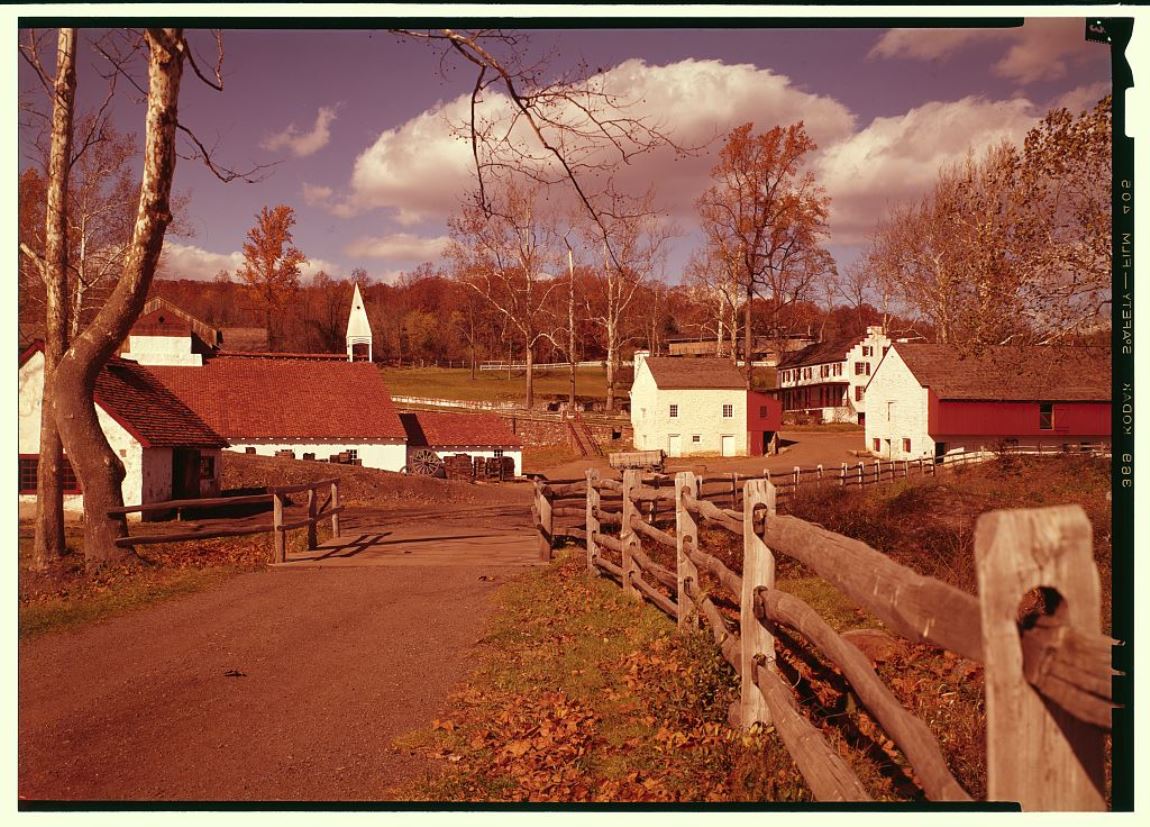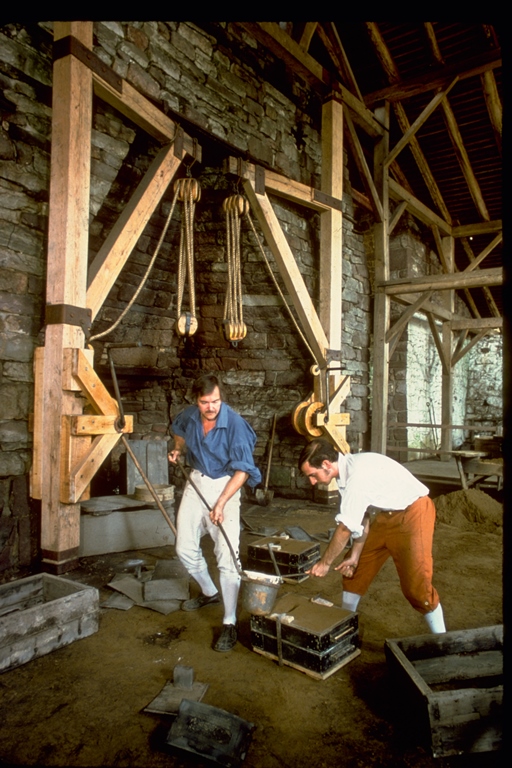We have probably all visited places or done things in our childhood that we’ve long since forgotten, and certainly didn’t appreciate the significance of it until much later in life. Thinking about the National Park Service’s Centennial and the #FindYourPark campaign recently brought back a memory of visiting Hopewell Furnace National Historic Site with my parents when I was a kid. I couldn’t have known it at the time, but I’m beginning to realize that a fun little day trip many years ago helped to pique my interest in and appreciation for historic places in ways that changed my life.
When I was about 10 years old my parents loaded my siblings and I in the car and drove us from our home near Kutztown to the southern tip of Berks County to join in a celebration. It was 1988 and Hopewell Furnace was celebrating its 50th anniversary as a unit of the National Park system. I can remember being confused – was this place real? Are the people talking to us actors? Why were they wearing funny clothes? Doesn’t charcoal come out of a bag?
But I can also remember watching with rapt attention as the man with the long apron retrieved the smoking kettle of glowing orange liquid from the fire and turned it into little metal bars right before my eyes. The wood frame building was enormous to a child my size and the smell of hot smoke was everywhere. I remember standing next to a different man in a tiny building while he swung a (relatively) huge hammer, turning one of those iron pieces into tiny nails – don’t nails come from the bins at the hardware store? And I remember helping to neatly stack wood into a tight mound that was later lit on fire. Was this going to be a bonfire?
![The Cast House at Hopewell Furnace. By Doug Kerr from Albany, NY, United States [CC BY-SA 2.0 (http://creativecommons.org/licenses/by-sa/2.0)], via Wikimedia Commons](https://pahistoricpreservation.com/wp-content/uploads/2016/03/Hopewell_Furnace_National_Historic_Site_-_Pennsylvania_5655041937.jpg)
The Cast House at Hopewell Furnace. By Doug Kerr from Albany, NY, United States [CC BY-SA 2.0 (http://creativecommons.org/licenses/by-sa/2.0)], via Wikimedia Commons
A Legacy Forged in Iron
Hopewell Furnace was one of dozens of 18th-century iron works that made Pennsylvania a critical player in the American Revolution, and later helped launch the state to the forefront of the industrial revolution in the 19th century. Founded by Mark Bird in 1771, Hopewell turned iron ore, limestone, and charcoal into pig iron that could be forged into a variety of metal products – nails, hinges, utensils, plows – and stove plates. The southeastern Pennsylvania countryside was rich with these natural resources and transected by fast flowing creeks that could be dammed for power. Proximity to Philadelphia, the largest English speaking city outside of London, meant that there was easy access to markets and transportation routes to sell these goods.
![Ten plate cookstoves cast at Hopewell Furnace. By National Park Service Digital Image Archives [Public domain], via Wikimedia Commons.](https://pahistoricpreservation.com/wp-content/uploads/2016/03/Hopewell_Furnace_National_Historical_Site_HOFU1334.jpg)
Ten plate cookstoves cast at Hopewell Furnace. By National Park Service Digital Image Archives [Public domain], via Wikimedia Commons.
![Architectural details of Tenant house No. 1 at Hopewell Furnace from the Historic American Buildings Survey. By Related names: Null, Druscilla J, historian Koch, Paul U, delineator [Public domain], via Wikimedia Commons](https://pahistoricpreservation.com/wp-content/uploads/2016/03/Hopewell_Village_Tenant_House_No._1_State_Route_345_vicinity_Hopewell_Chester_County_PA_HABS_PA6-HOPVI19-_sheet_7_of_7.png)
Architectural details of Tenant house No. 1 at Hopewell Furnace from the Historic American Buildings Survey. By Related names: Null, Druscilla J, historian Koch, Paul U, delineator [Public domain], via Wikimedia Commons
Who Says You Can’t Go Back Again?
Some years after my first visit to Hopewell with my family, I again found myself wandering past the buildings unexpectedly. Each summer starting at age 7, I spent a week at a camp that nearly bordered the furnace, which is entirely surrounded by French Creek State Park. One of our activities during camp would be a day hike to a nearby church, St. Peter’s Village, or if you were old enough, to Hopewell Furnace. I can remember the line of kids and our college-aged counselors marching along the Horseshoe Trail, winding down the craggy hillsides, and navigating the rocky creek crossings. Modern day French Creek State Park had once been the land that supplied Hopewell with water, stone, timber, and iron and scattered amongst the forest were remnants of the charcoal pits, mill races, and rock outcroppings. When the National Park Service assumed ownership of the 5,000+ acres of the Hopewell property during World War II, they kept the historic core of the furnace and gave the surrounding land to the Commonwealth of Pennsylvania for use as a park. I eventually became a counselor at the camp and led my own groups of campers on day trips and overnight excursions through French Creek and Hopewell Furnace.
![Hopewell Furnace showcases an early American industrial landscape from natural resource extraction to enlightened conservation. By National Park Service Digital Image Archives [Public domain], via Wikimedia Commons.](https://pahistoricpreservation.com/wp-content/uploads/2016/03/Hopewell_Furnace_National_Historical_Site_HOFU1032.jpg)
Hopewell Furnace showcases an early American industrial landscape from natural resource extraction to enlightened conservation. By National Park Service Digital Image Archives [Public domain], via Wikimedia Commons.
Comment Policy
PHMC welcomes and encourages topic-related comments on this blog. PHMC reserves the right to remove comments that in PHMC’s discretion do not follow participation guidelines.
Commenters and Comments shall be related to the blog post topic and respectful of others who use this site.
Commenters and Comments shall not: use language that is offensive, inflammatory or provocative (this includes, but is not limited to, using profanity, obscene, or vulgar comments); disparage other commenters or people; condone illegal activity; identify the location of known or suspected archeological sites; post personal information in comments such as addresses, phone numbers, e-mail addresses or other contact details, which may relate to you or other individuals; impersonate or falsely claim to represent a person or an organization; make any commercial endorsement or promotion of any product, service or publication.
If you would like to comment on other topics not related to this blog post but related to PHMC, please fill out the PHMC Contact Us Form.


Great story! You probably don’t remember, but I was one of those seasonal park rangers (wearing the “Smokey Bear” hat) that August day in 1988. They used to have costumed interpretation at the various buildings at the park, but government cutbacks led to interpretation at just a few buildings (except for Establishment Day, when lots of volunteers came and demonstrated the crafts of the early 19th century). The last time I visited Hopewell, they had resumed costumed interpretation at several of the buildings, and one of the demonstrators at the Cast House was someone who I had worked with back in the 1980s. It’s a great place and overlooked…and when I get back to Berks County, I definitely will stop there and #FindMyPark.
Thanks, Karen!That trip was clearly memorable, but a little overwhelming for a kid my age and the few details I can remember are all positive and fun. Somewhere I have a comerative pin from the anniversary and this memory has renewed my desire to dig it up!
Your passion for Military History shines through every article. Thank you for your hard work and dedication!